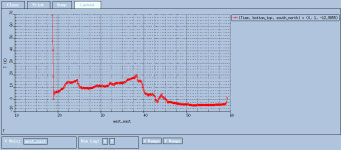Dear all,
I've a question concerning the lateral boundary conditions for a real case run.
I'm running WRF Verion 4.1 on a distributed memory HPC system.
My region of interest is the Great Rift Valley in Ethiopia.
While running wrf.exe, my lateral boundary conditions changed in the spec_zone. If I understood the documentation (https://www2.mmm.ucar.edu/wrf/users/docs/user_guide_V3/users_guide_chap5.htm#Phys -> Lateral Boundary Condition Options d) ), that's usually the region defined and fixed by the input data. I use the HRES analysis from the ECMWF as input data.
After more than 24h runtime, the values for some variables are completely off in the spec_zone. One example is the skin temperature. I'll get values up to 372 K whereas the input data shows values up to 320 K at the same time and area. So the boundary conditions seem to be adapted although they should be fixed.
Does anyone has an idea what happened here?
I'm not in an urgent need but rather interested.
I actually solved it with increasing the layer top from 40hPa to 20hPa (what I should have done in the first place), but still wondering what could be reason for the adaption in the boundary conditions before. I thought of a reflection at the model top or something like this.
Furthermore, it seems that the spec_zone is not fixed after real.exe.
I'll attach my namelist, However, for my "successful" run I changed some more things than just the model top.
I'll also attach a plot generated with ncview that shows in the left hand side (western lateral boundary condition) the abrupt increase of the skin temperature
If more information is needed I'll be happy to provide anything I can.
Looking forward to an answer!
Cheers,
Cornelius
I've a question concerning the lateral boundary conditions for a real case run.
I'm running WRF Verion 4.1 on a distributed memory HPC system.
My region of interest is the Great Rift Valley in Ethiopia.
While running wrf.exe, my lateral boundary conditions changed in the spec_zone. If I understood the documentation (https://www2.mmm.ucar.edu/wrf/users/docs/user_guide_V3/users_guide_chap5.htm#Phys -> Lateral Boundary Condition Options d) ), that's usually the region defined and fixed by the input data. I use the HRES analysis from the ECMWF as input data.
After more than 24h runtime, the values for some variables are completely off in the spec_zone. One example is the skin temperature. I'll get values up to 372 K whereas the input data shows values up to 320 K at the same time and area. So the boundary conditions seem to be adapted although they should be fixed.
Does anyone has an idea what happened here?
I'm not in an urgent need but rather interested.
I actually solved it with increasing the layer top from 40hPa to 20hPa (what I should have done in the first place), but still wondering what could be reason for the adaption in the boundary conditions before. I thought of a reflection at the model top or something like this.
Furthermore, it seems that the spec_zone is not fixed after real.exe.
I'll attach my namelist, However, for my "successful" run I changed some more things than just the model top.
I'll also attach a plot generated with ncview that shows in the left hand side (western lateral boundary condition) the abrupt increase of the skin temperature
If more information is needed I'll be happy to provide anything I can.
Looking forward to an answer!
Cheers,
Cornelius









